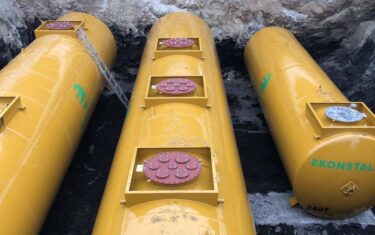






Interesting information about the project
Two different orders for the same customer completed within a few months amount to a total of six underground tanks, allowing for the storage of as much as 290,000 litres of fuel. These tanks were pitted at two newly opened gas stations, operating under the brand name of a well-known Austrian fuel concern.
These stations allow residents of Prague and Brno, the two largest cities in the Czech Republic, to refuel their cars conveniently. As part of this order, we delivered:
- two single-chamber tanks with a capacity of 25 m3 each,
- two two-chamber tanks with a total capacity of 60 m3 each (one chamber with a capacity of 40 m3 and one chamber with a capacity of 20 m3),
- two three-chamber tanks with a capacity of 60 m3 each (one chamber with a capacity of 30 m3 and two chambers with a capacity of 15 m3).
The advantage of multi-chamber tanks is the possibility of storing different types of fuel and diesel oil in the same tank, without the risk of mutual contact between the substances. This is important, e.g. in the case of petrol stations located in places with heavy traffic, used by drivers using various vehicles powered by both conventional and alternative fuels. When building a gas station in an urban area, the investor is often faced with lack of available space and meeting the regulations on e.g. distance of fuel tanks from the nearest buildings. These regulations vary depending on the country. Multi-chamber tanks enable to secure the availability of different types of fuel, without having to install a separate tank for each of them.
All tanks have been externally protected with Endoprene coating, which protects the metal structure against corrosion. These are horizontal, twin wall / double skin tanks with zero foundations. These types of foundations are a non-standard solution. The customer chose this type of construction due to the need to stabilize the tanks on the foundation plate without lifting them above its surface.

